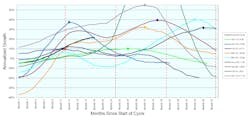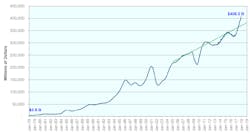In its latest release of semiconductor market revenue statistics, the World Semiconductor Trade Statistics (WSTS) organization measured global revenue for 2017 at $406.5 billion. This level of revenue marks a major milestone for the semiconductor industry as it saw revenues jump by 21.2% in 2017 compared to 0.1% in 2016. The last major calendar-year growth in the semiconductor industry occurred in 2010 when revenues grew by 34.1% to top $300 billion for the first time at $311.4 billion. The year 2010 saw revenues expand by over $79 billion while 2017 saw revenues jump by $71 billion. While the growth in revenues was broad based across most segments of the semiconductor industry, the memory markets achieved some of the most dramatic growth in over ten years.
DRAM and NAND Flash Dominate Growth and Revenues
Throughout the history of the semiconductor industry, the DRAM and NAND flash markets have exhibited highly volatile growth patterns. The growth in these markets typically skews overall market growth up or down from the growth achieved in other market segments such as logic, processors, analog, discrete, optical and sensor markets. Combined DRAM and NAND flash revenues grew by 64% in 2017 while all other markets combined grew by 9.2%. By comparison, the other major growth year of 2010 saw combined DRAM and NAND Flash revenues grow by over 68% with all other markets combined growing by nearly 28%. However, the increase in actual combined revenues for DRAM and NAND Flash in 2017 was nearly $47 billion. This is nearly double the $24.7 billion increase for the same markets in 2010.
Perhaps the most telling statistic in revenues for the past year is the share of total semiconductor revenues captured by DRAM and NAND Flash in 2017. Their combined share of revenues leapt to 29.5%. Over the previous four years these markets accounted for 20% to 22% of total revenues, the highest share of the market to that point. Consolidation in the number of semiconductor suppliers has seen the number of major suppliers of memory components contract to just a handful of companies lead by Samsung Semiconductor, SK Hynix and Micron Technology. This same handful of companies now control nearly 1/3rd of the semiconductor industry with their DRAM and NAND Flash revenues. This gives them significantly expanded power within the semiconductor supply chain.
The Status of the Tenth Cycle in Semiconductor Market History
The semiconductor market has exhibited cyclical behavior in its growth patterns throughout history. As illustrated in Figure 1, the semiconductor industry is in the midst of its tenth cycle. This figure is based on WSTS data going back to 1978 when total industry revenues were less than $4 billion, under 1% of revenues in 2017. Each cycle is shown starting at the bottom of the previous cycle where revenue growth begins to increase. Using the monthly data reported by WSTS it is possible to calculate annualized revenue growth on a month-to-month basis. Many insights can be gleaned from a visual analysis of industry cycles. In this representation, the two most obvious points to be seen are: (1) the most recent cycles have proceeded directly to a peak without any pause in growth (Earlier market cycles saw a pause in growth before reaching a peak) and (2) the current cycle appears to be reaching its peak. The current trend of annual growth compared to quarter-over-quarter growth would indicate that annual growth will begin to slow in the summer of 2018.
Figure 1 – Semiconductor Industry Cycles
Long-Term Growth Perspective
Years of dramatic growth or decline in the semiconductor industry present significant challenges for participants up and down the supply chain. Matching supply and demand and navigating pricing swings test the most seasoned suppliers and procurement managers. It is helpful to remember that the semiconductor industry is similar to the stock market in that the market will see both expansion and contraction. This is seen in Fig. 2. In the long term the market has shown it will continue to sustain growth in spite of impacts from economic cycles, disruptive technologies, regional shifts, etc. Since 2005 the semiconductor industry has grown by roughly five percent on average. This long term 5% growth average is shown by the green line imposed on the actual industry revenues. With all of the ups and downs in this cyclical industry it is a reasonably safe bet that this long-term pattern of growth will continue.
Figure 2 – Annualized Semiconductor Revenue











